Business Strategy Report: Aldi's Strategic Positioning Analysis
VerifiedAdded on 2020/07/22
|27
|6875
|47
Report
AI Summary
This report provides a comprehensive analysis of Aldi's business strategy. It begins with an introduction to Aldi, including its mission, vision, objectives, and goals, emphasizing its commitment to providing quality goods at reasonable prices and its aim to be a leading supermarket chain. The report then delves into the factors considered during strategic planning, such as customer needs, competitor analysis, portfolio management, and SWOT analysis. It evaluates techniques used for developing strategic plans, including the GE matrix and BCG matrix, to assess Aldi's strategic position. The analysis extends to an environmental audit using the five forces model and a stakeholder analysis to formulate new strategies. The report further evaluates the appropriateness of different strategies, selects a market development strategy, and justifies its selection. Finally, it outlines the roles, responsibilities, and resources required for implementing the new strategy, including the use of SMART targets.
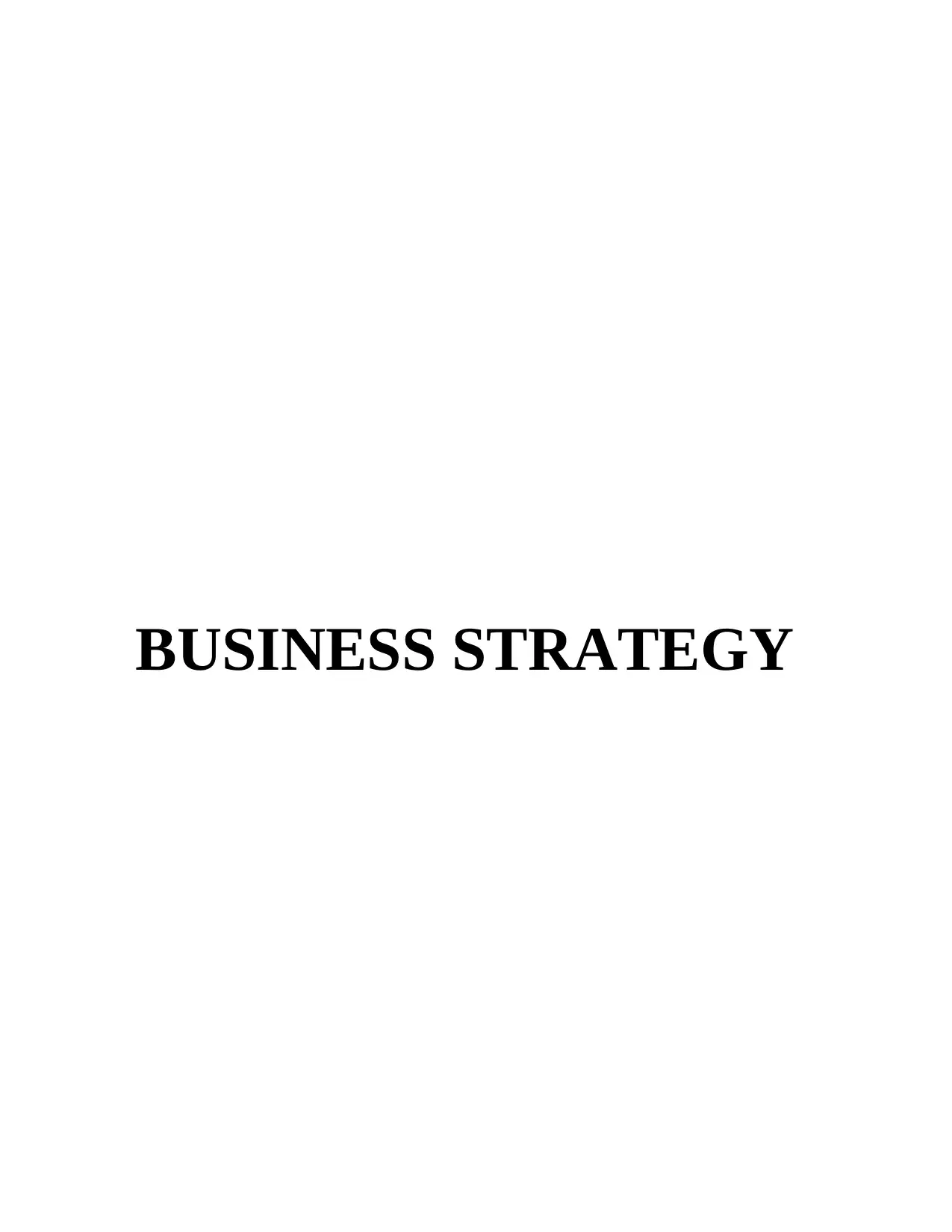
BUSINESS STRATEGY
Paraphrase This Document
Need a fresh take? Get an instant paraphrase of this document with our AI Paraphraser
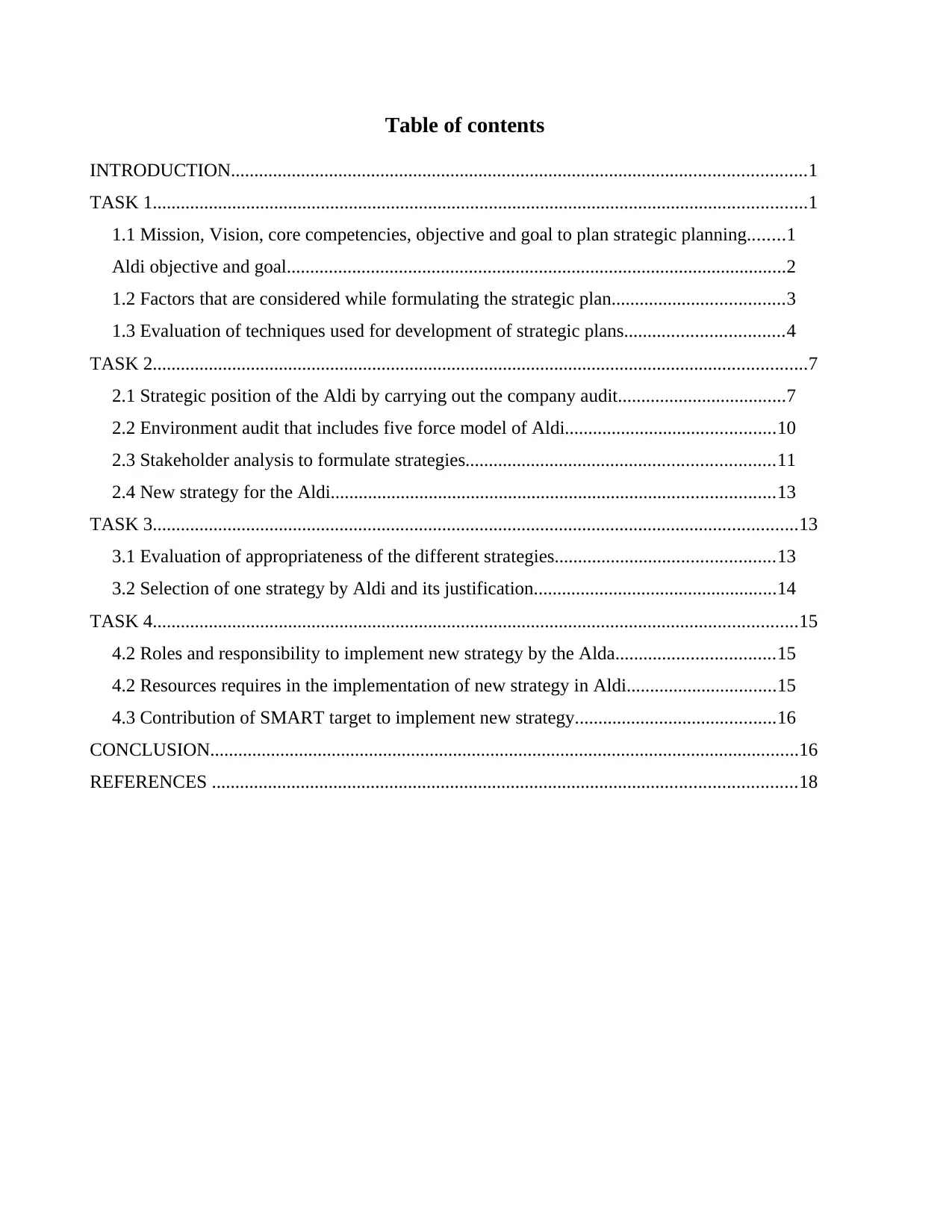
Table of contents
INTRODUCTION...........................................................................................................................1
TASK 1............................................................................................................................................1
1.1 Mission, Vision, core competencies, objective and goal to plan strategic planning........1
Aldi objective and goal...........................................................................................................2
1.2 Factors that are considered while formulating the strategic plan.....................................3
1.3 Evaluation of techniques used for development of strategic plans..................................4
TASK 2............................................................................................................................................7
2.1 Strategic position of the Aldi by carrying out the company audit....................................7
2.2 Environment audit that includes five force model of Aldi.............................................10
2.3 Stakeholder analysis to formulate strategies..................................................................11
2.4 New strategy for the Aldi...............................................................................................13
TASK 3..........................................................................................................................................13
3.1 Evaluation of appropriateness of the different strategies...............................................13
3.2 Selection of one strategy by Aldi and its justification....................................................14
TASK 4..........................................................................................................................................15
4.2 Roles and responsibility to implement new strategy by the Alda..................................15
4.2 Resources requires in the implementation of new strategy in Aldi................................15
4.3 Contribution of SMART target to implement new strategy...........................................16
CONCLUSION..............................................................................................................................16
REFERENCES .............................................................................................................................18
INTRODUCTION...........................................................................................................................1
TASK 1............................................................................................................................................1
1.1 Mission, Vision, core competencies, objective and goal to plan strategic planning........1
Aldi objective and goal...........................................................................................................2
1.2 Factors that are considered while formulating the strategic plan.....................................3
1.3 Evaluation of techniques used for development of strategic plans..................................4
TASK 2............................................................................................................................................7
2.1 Strategic position of the Aldi by carrying out the company audit....................................7
2.2 Environment audit that includes five force model of Aldi.............................................10
2.3 Stakeholder analysis to formulate strategies..................................................................11
2.4 New strategy for the Aldi...............................................................................................13
TASK 3..........................................................................................................................................13
3.1 Evaluation of appropriateness of the different strategies...............................................13
3.2 Selection of one strategy by Aldi and its justification....................................................14
TASK 4..........................................................................................................................................15
4.2 Roles and responsibility to implement new strategy by the Alda..................................15
4.2 Resources requires in the implementation of new strategy in Aldi................................15
4.3 Contribution of SMART target to implement new strategy...........................................16
CONCLUSION..............................................................................................................................16
REFERENCES .............................................................................................................................18

Illustration Index
Illustration 1: GE matrix..................................................................................................................4
Illustration 2: BCG Matrix...............................................................................................................5
Illustration 3: Value chain................................................................................................................8
Illustration 4: Stakeholder Matrix..................................................................................................11
Illustration 1: GE matrix..................................................................................................................4
Illustration 2: BCG Matrix...............................................................................................................5
Illustration 3: Value chain................................................................................................................8
Illustration 4: Stakeholder Matrix..................................................................................................11
⊘ This is a preview!⊘
Do you want full access?
Subscribe today to unlock all pages.

Trusted by 1+ million students worldwide
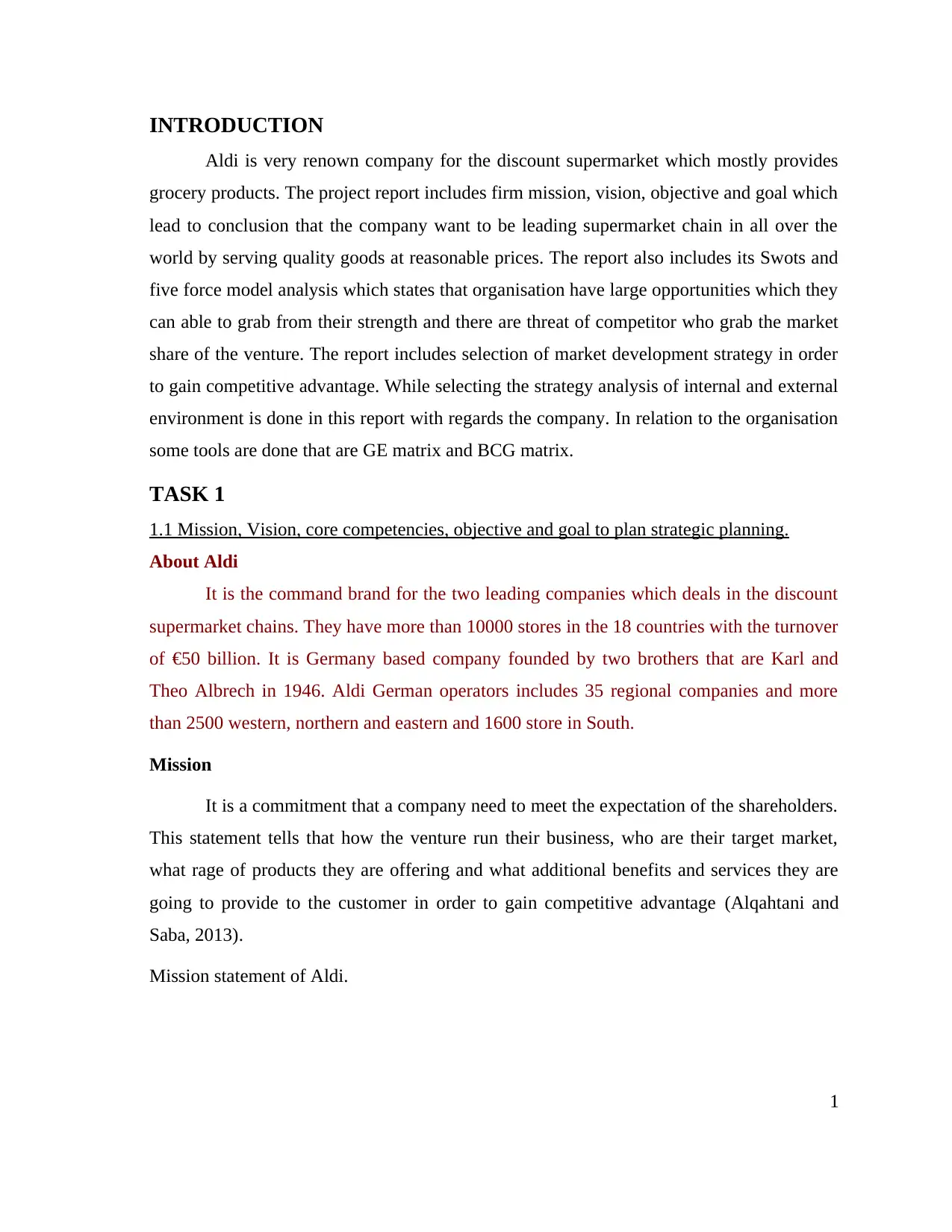
INTRODUCTION
Aldi is very renown company for the discount supermarket which mostly provides
grocery products. The project report includes firm mission, vision, objective and goal which
lead to conclusion that the company want to be leading supermarket chain in all over the
world by serving quality goods at reasonable prices. The report also includes its Swots and
five force model analysis which states that organisation have large opportunities which they
can able to grab from their strength and there are threat of competitor who grab the market
share of the venture. The report includes selection of market development strategy in order
to gain competitive advantage. While selecting the strategy analysis of internal and external
environment is done in this report with regards the company. In relation to the organisation
some tools are done that are GE matrix and BCG matrix.
TASK 1
1.1 Mission, Vision, core competencies, objective and goal to plan strategic planning.
About Aldi
It is the command brand for the two leading companies which deals in the discount
supermarket chains. They have more than 10000 stores in the 18 countries with the turnover
of €50 billion. It is Germany based company founded by two brothers that are Karl and
Theo Albrech in 1946. Aldi German operators includes 35 regional companies and more
than 2500 western, northern and eastern and 1600 store in South.
Mission
It is a commitment that a company need to meet the expectation of the shareholders.
This statement tells that how the venture run their business, who are their target market,
what rage of products they are offering and what additional benefits and services they are
going to provide to the customer in order to gain competitive advantage (Alqahtani and
Saba, 2013).
Mission statement of Aldi.
1
Aldi is very renown company for the discount supermarket which mostly provides
grocery products. The project report includes firm mission, vision, objective and goal which
lead to conclusion that the company want to be leading supermarket chain in all over the
world by serving quality goods at reasonable prices. The report also includes its Swots and
five force model analysis which states that organisation have large opportunities which they
can able to grab from their strength and there are threat of competitor who grab the market
share of the venture. The report includes selection of market development strategy in order
to gain competitive advantage. While selecting the strategy analysis of internal and external
environment is done in this report with regards the company. In relation to the organisation
some tools are done that are GE matrix and BCG matrix.
TASK 1
1.1 Mission, Vision, core competencies, objective and goal to plan strategic planning.
About Aldi
It is the command brand for the two leading companies which deals in the discount
supermarket chains. They have more than 10000 stores in the 18 countries with the turnover
of €50 billion. It is Germany based company founded by two brothers that are Karl and
Theo Albrech in 1946. Aldi German operators includes 35 regional companies and more
than 2500 western, northern and eastern and 1600 store in South.
Mission
It is a commitment that a company need to meet the expectation of the shareholders.
This statement tells that how the venture run their business, who are their target market,
what rage of products they are offering and what additional benefits and services they are
going to provide to the customer in order to gain competitive advantage (Alqahtani and
Saba, 2013).
Mission statement of Aldi.
1
Paraphrase This Document
Need a fresh take? Get an instant paraphrase of this document with our AI Paraphraser
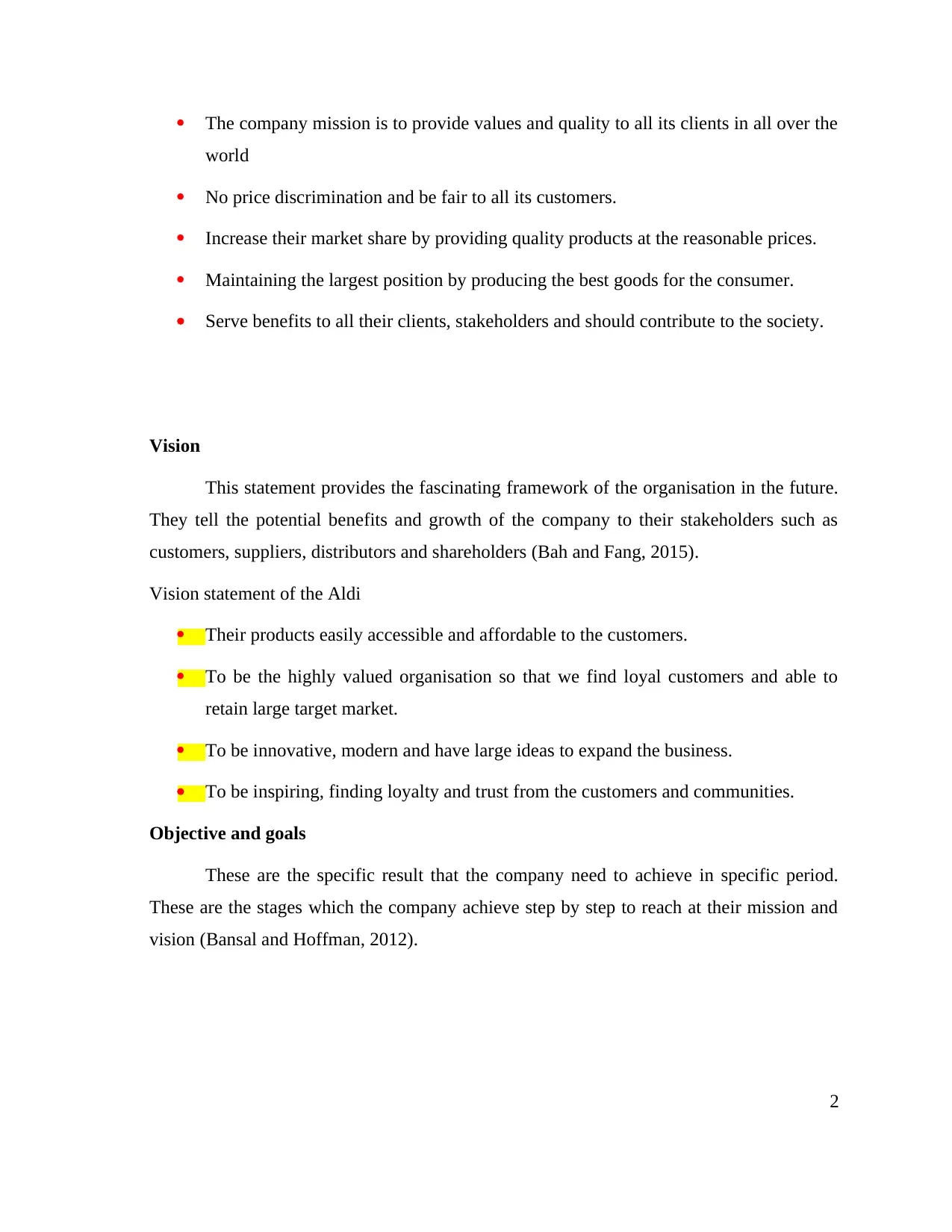
The company mission is to provide values and quality to all its clients in all over the
world
No price discrimination and be fair to all its customers.
Increase their market share by providing quality products at the reasonable prices.
Maintaining the largest position by producing the best goods for the consumer.
Serve benefits to all their clients, stakeholders and should contribute to the society.
Vision
This statement provides the fascinating framework of the organisation in the future.
They tell the potential benefits and growth of the company to their stakeholders such as
customers, suppliers, distributors and shareholders (Bah and Fang, 2015).
Vision statement of the Aldi
Their products easily accessible and affordable to the customers.
To be the highly valued organisation so that we find loyal customers and able to
retain large target market.
To be innovative, modern and have large ideas to expand the business.
To be inspiring, finding loyalty and trust from the customers and communities.
Objective and goals
These are the specific result that the company need to achieve in specific period.
These are the stages which the company achieve step by step to reach at their mission and
vision (Bansal and Hoffman, 2012).
2
world
No price discrimination and be fair to all its customers.
Increase their market share by providing quality products at the reasonable prices.
Maintaining the largest position by producing the best goods for the consumer.
Serve benefits to all their clients, stakeholders and should contribute to the society.
Vision
This statement provides the fascinating framework of the organisation in the future.
They tell the potential benefits and growth of the company to their stakeholders such as
customers, suppliers, distributors and shareholders (Bah and Fang, 2015).
Vision statement of the Aldi
Their products easily accessible and affordable to the customers.
To be the highly valued organisation so that we find loyal customers and able to
retain large target market.
To be innovative, modern and have large ideas to expand the business.
To be inspiring, finding loyalty and trust from the customers and communities.
Objective and goals
These are the specific result that the company need to achieve in specific period.
These are the stages which the company achieve step by step to reach at their mission and
vision (Bansal and Hoffman, 2012).
2

The objective are often medium or short term which express the company's goal in more
detail whereas goal are long termed plan that are wide in nature and have been expressed
generally.
Aldi objective and goal
To be the most preferred by the customer.
To make sure that the clients are stick to their supermarket, not switch to other
competitors.
To be the leader on the market in all the way.
To enhance their skills and knowledge of the employees up to the international level
make them knowledgeable about the customer relationship management.
Support and drive ISO standard throughout their products (Bøllingtoft, 2012).
Open positive team environment to disseminate direction, opportunities and ideas to
all their supermarket level and appropriate to take stakeholders.
Organisation environment should be conflict free.
Serve high quality and fashion based goods to the client with the affordable prices.
The main objective of the strategic planning is to set desired priorities and focus
employees energy towards the specific goal by providing resources and operation and make
sure all the employees and stakeholders to more towards the achievement of conman goal
(Bøllingtoft, 2012). The key objective is to decide:
What the company is?
What are their operation?
What products and services they serve?
What are their purpose for that they are surviving?
What are their future objective and goals?
Mission, vision, goals, objective and core competences help the organisation to
know the needs and wants of the consumer and guideline how they can serve quality
products and services so that customer will satisfy. It helps the company to plan their
3
detail whereas goal are long termed plan that are wide in nature and have been expressed
generally.
Aldi objective and goal
To be the most preferred by the customer.
To make sure that the clients are stick to their supermarket, not switch to other
competitors.
To be the leader on the market in all the way.
To enhance their skills and knowledge of the employees up to the international level
make them knowledgeable about the customer relationship management.
Support and drive ISO standard throughout their products (Bøllingtoft, 2012).
Open positive team environment to disseminate direction, opportunities and ideas to
all their supermarket level and appropriate to take stakeholders.
Organisation environment should be conflict free.
Serve high quality and fashion based goods to the client with the affordable prices.
The main objective of the strategic planning is to set desired priorities and focus
employees energy towards the specific goal by providing resources and operation and make
sure all the employees and stakeholders to more towards the achievement of conman goal
(Bøllingtoft, 2012). The key objective is to decide:
What the company is?
What are their operation?
What products and services they serve?
What are their purpose for that they are surviving?
What are their future objective and goals?
Mission, vision, goals, objective and core competences help the organisation to
know the needs and wants of the consumer and guideline how they can serve quality
products and services so that customer will satisfy. It helps the company to plan their
3
⊘ This is a preview!⊘
Do you want full access?
Subscribe today to unlock all pages.

Trusted by 1+ million students worldwide
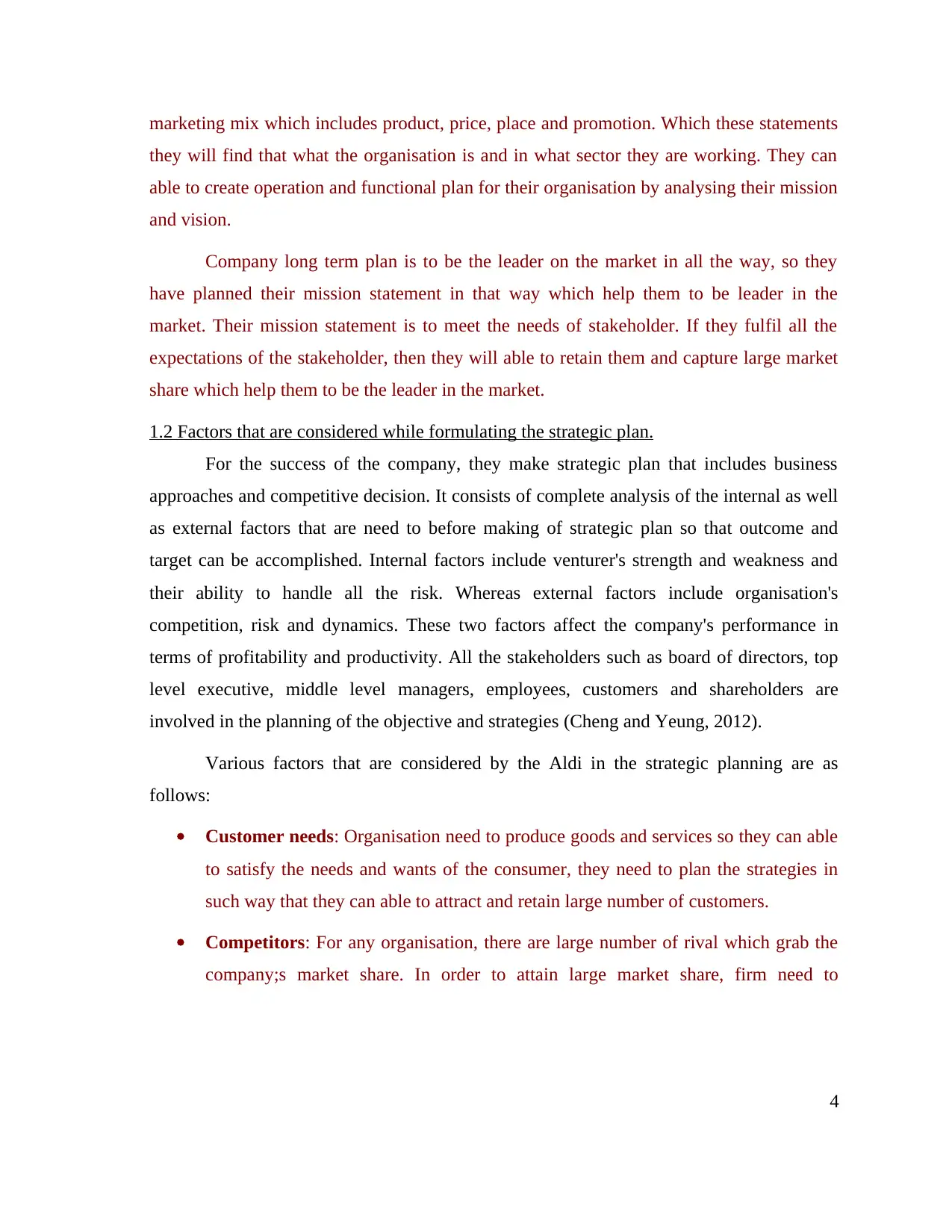
marketing mix which includes product, price, place and promotion. Which these statements
they will find that what the organisation is and in what sector they are working. They can
able to create operation and functional plan for their organisation by analysing their mission
and vision.
Company long term plan is to be the leader on the market in all the way, so they
have planned their mission statement in that way which help them to be leader in the
market. Their mission statement is to meet the needs of stakeholder. If they fulfil all the
expectations of the stakeholder, then they will able to retain them and capture large market
share which help them to be the leader in the market.
1.2 Factors that are considered while formulating the strategic plan.
For the success of the company, they make strategic plan that includes business
approaches and competitive decision. It consists of complete analysis of the internal as well
as external factors that are need to before making of strategic plan so that outcome and
target can be accomplished. Internal factors include venturer's strength and weakness and
their ability to handle all the risk. Whereas external factors include organisation's
competition, risk and dynamics. These two factors affect the company's performance in
terms of profitability and productivity. All the stakeholders such as board of directors, top
level executive, middle level managers, employees, customers and shareholders are
involved in the planning of the objective and strategies (Cheng and Yeung, 2012).
Various factors that are considered by the Aldi in the strategic planning are as
follows:
Customer needs: Organisation need to produce goods and services so they can able
to satisfy the needs and wants of the consumer, they need to plan the strategies in
such way that they can able to attract and retain large number of customers.
Competitors: For any organisation, there are large number of rival which grab the
company;s market share. In order to attain large market share, firm need to
4
they will find that what the organisation is and in what sector they are working. They can
able to create operation and functional plan for their organisation by analysing their mission
and vision.
Company long term plan is to be the leader on the market in all the way, so they
have planned their mission statement in that way which help them to be leader in the
market. Their mission statement is to meet the needs of stakeholder. If they fulfil all the
expectations of the stakeholder, then they will able to retain them and capture large market
share which help them to be the leader in the market.
1.2 Factors that are considered while formulating the strategic plan.
For the success of the company, they make strategic plan that includes business
approaches and competitive decision. It consists of complete analysis of the internal as well
as external factors that are need to before making of strategic plan so that outcome and
target can be accomplished. Internal factors include venturer's strength and weakness and
their ability to handle all the risk. Whereas external factors include organisation's
competition, risk and dynamics. These two factors affect the company's performance in
terms of profitability and productivity. All the stakeholders such as board of directors, top
level executive, middle level managers, employees, customers and shareholders are
involved in the planning of the objective and strategies (Cheng and Yeung, 2012).
Various factors that are considered by the Aldi in the strategic planning are as
follows:
Customer needs: Organisation need to produce goods and services so they can able
to satisfy the needs and wants of the consumer, they need to plan the strategies in
such way that they can able to attract and retain large number of customers.
Competitors: For any organisation, there are large number of rival which grab the
company;s market share. In order to attain large market share, firm need to
4
Paraphrase This Document
Need a fresh take? Get an instant paraphrase of this document with our AI Paraphraser
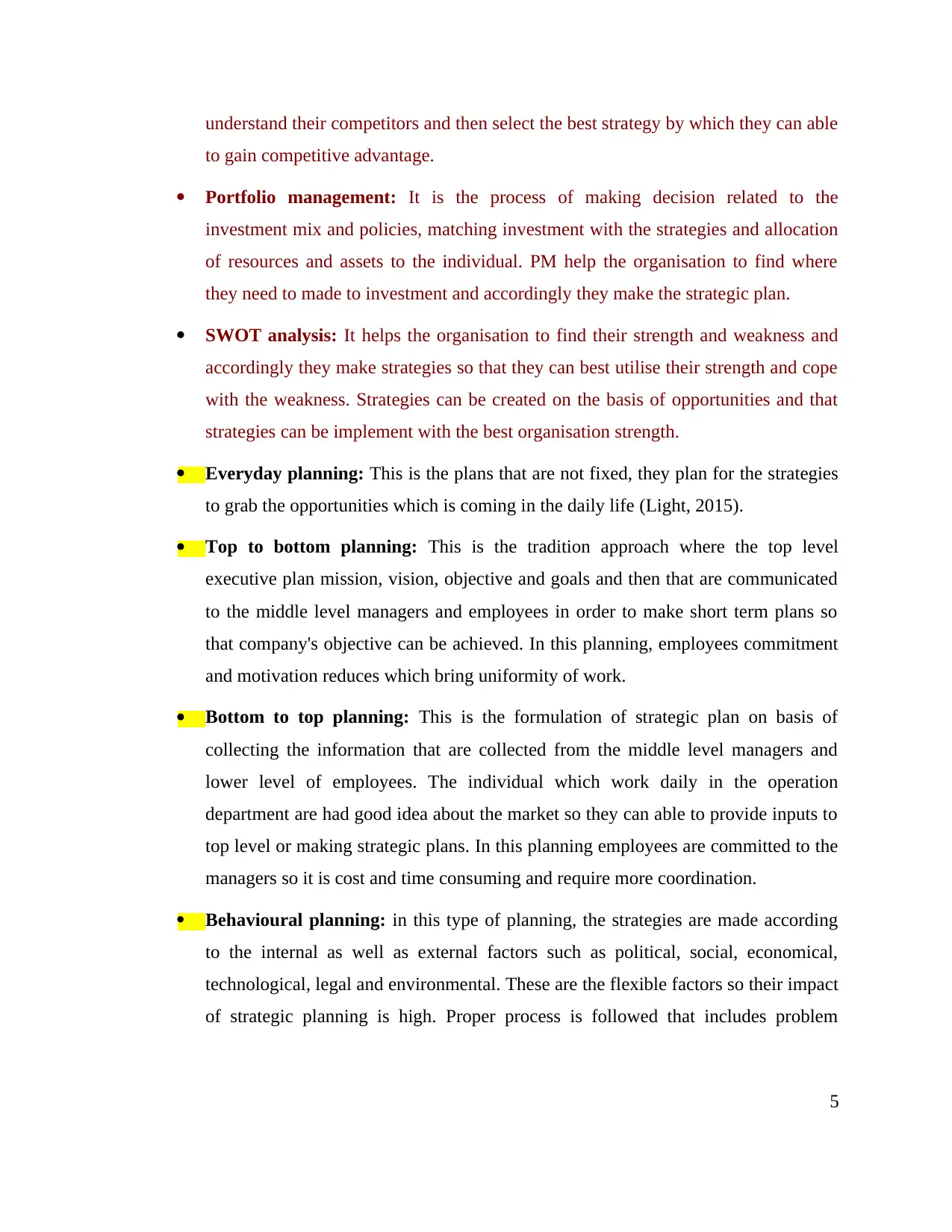
understand their competitors and then select the best strategy by which they can able
to gain competitive advantage.
Portfolio management: It is the process of making decision related to the
investment mix and policies, matching investment with the strategies and allocation
of resources and assets to the individual. PM help the organisation to find where
they need to made to investment and accordingly they make the strategic plan.
SWOT analysis: It helps the organisation to find their strength and weakness and
accordingly they make strategies so that they can best utilise their strength and cope
with the weakness. Strategies can be created on the basis of opportunities and that
strategies can be implement with the best organisation strength.
Everyday planning: This is the plans that are not fixed, they plan for the strategies
to grab the opportunities which is coming in the daily life (Light, 2015).
Top to bottom planning: This is the tradition approach where the top level
executive plan mission, vision, objective and goals and then that are communicated
to the middle level managers and employees in order to make short term plans so
that company's objective can be achieved. In this planning, employees commitment
and motivation reduces which bring uniformity of work.
Bottom to top planning: This is the formulation of strategic plan on basis of
collecting the information that are collected from the middle level managers and
lower level of employees. The individual which work daily in the operation
department are had good idea about the market so they can able to provide inputs to
top level or making strategic plans. In this planning employees are committed to the
managers so it is cost and time consuming and require more coordination.
Behavioural planning: in this type of planning, the strategies are made according
to the internal as well as external factors such as political, social, economical,
technological, legal and environmental. These are the flexible factors so their impact
of strategic planning is high. Proper process is followed that includes problem
5
to gain competitive advantage.
Portfolio management: It is the process of making decision related to the
investment mix and policies, matching investment with the strategies and allocation
of resources and assets to the individual. PM help the organisation to find where
they need to made to investment and accordingly they make the strategic plan.
SWOT analysis: It helps the organisation to find their strength and weakness and
accordingly they make strategies so that they can best utilise their strength and cope
with the weakness. Strategies can be created on the basis of opportunities and that
strategies can be implement with the best organisation strength.
Everyday planning: This is the plans that are not fixed, they plan for the strategies
to grab the opportunities which is coming in the daily life (Light, 2015).
Top to bottom planning: This is the tradition approach where the top level
executive plan mission, vision, objective and goals and then that are communicated
to the middle level managers and employees in order to make short term plans so
that company's objective can be achieved. In this planning, employees commitment
and motivation reduces which bring uniformity of work.
Bottom to top planning: This is the formulation of strategic plan on basis of
collecting the information that are collected from the middle level managers and
lower level of employees. The individual which work daily in the operation
department are had good idea about the market so they can able to provide inputs to
top level or making strategic plans. In this planning employees are committed to the
managers so it is cost and time consuming and require more coordination.
Behavioural planning: in this type of planning, the strategies are made according
to the internal as well as external factors such as political, social, economical,
technological, legal and environmental. These are the flexible factors so their impact
of strategic planning is high. Proper process is followed that includes problem
5

awareness, problem diagnosis, solution development, solution selection and
implementation (Alqahtani and Saba, 2013).
1.3 Evaluation of techniques used for development of strategic plans.
Different techniques have been used by the Aldi for making strategic plans that are
as follows. In the Aldi case, which is having different supermarket in various countries use
different platforms to analyse their strength, weaknesses, opportunities and threats in order
to make strategic plans that are as follows:
GE matrix
Illustration 1: GE matrix
(Source: GE Matrix, marketing theories, 2016)
In the organisation, the resources are scare so the effect the decision making of the
company. As the resources are limited and opportunities are unlimited so the firm need to
make decision in such a way that they can use the resources in proper way to produce
quality products in order to achieve opportunities (Bah and Fang, 2015). Organisation need
to make investment in all the level between the departments, functional level business and
division so the question arise that where the company need to invest high and where to
invest low. BE matrix helps the venture to take decision regarding the investment. GE
6
implementation (Alqahtani and Saba, 2013).
1.3 Evaluation of techniques used for development of strategic plans.
Different techniques have been used by the Aldi for making strategic plans that are
as follows. In the Aldi case, which is having different supermarket in various countries use
different platforms to analyse their strength, weaknesses, opportunities and threats in order
to make strategic plans that are as follows:
GE matrix
Illustration 1: GE matrix
(Source: GE Matrix, marketing theories, 2016)
In the organisation, the resources are scare so the effect the decision making of the
company. As the resources are limited and opportunities are unlimited so the firm need to
make decision in such a way that they can use the resources in proper way to produce
quality products in order to achieve opportunities (Bah and Fang, 2015). Organisation need
to make investment in all the level between the departments, functional level business and
division so the question arise that where the company need to invest high and where to
invest low. BE matrix helps the venture to take decision regarding the investment. GE
6
⊘ This is a preview!⊘
Do you want full access?
Subscribe today to unlock all pages.

Trusted by 1+ million students worldwide
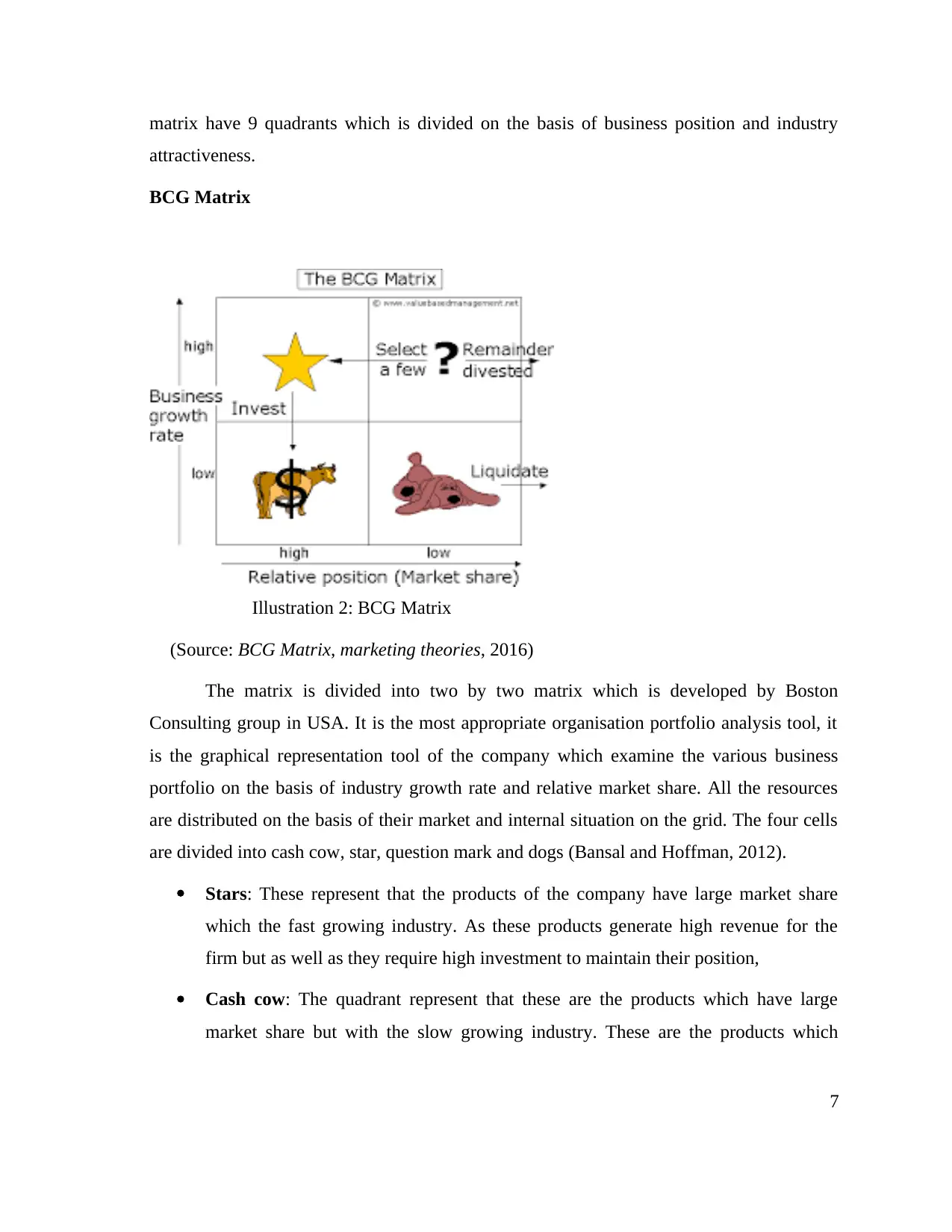
matrix have 9 quadrants which is divided on the basis of business position and industry
attractiveness.
BCG Matrix
Illustration 2: BCG Matrix
(Source: BCG Matrix, marketing theories, 2016)
The matrix is divided into two by two matrix which is developed by Boston
Consulting group in USA. It is the most appropriate organisation portfolio analysis tool, it
is the graphical representation tool of the company which examine the various business
portfolio on the basis of industry growth rate and relative market share. All the resources
are distributed on the basis of their market and internal situation on the grid. The four cells
are divided into cash cow, star, question mark and dogs (Bansal and Hoffman, 2012).
Stars: These represent that the products of the company have large market share
which the fast growing industry. As these products generate high revenue for the
firm but as well as they require high investment to maintain their position,
Cash cow: The quadrant represent that these are the products which have large
market share but with the slow growing industry. These are the products which
7
attractiveness.
BCG Matrix
Illustration 2: BCG Matrix
(Source: BCG Matrix, marketing theories, 2016)
The matrix is divided into two by two matrix which is developed by Boston
Consulting group in USA. It is the most appropriate organisation portfolio analysis tool, it
is the graphical representation tool of the company which examine the various business
portfolio on the basis of industry growth rate and relative market share. All the resources
are distributed on the basis of their market and internal situation on the grid. The four cells
are divided into cash cow, star, question mark and dogs (Bansal and Hoffman, 2012).
Stars: These represent that the products of the company have large market share
which the fast growing industry. As these products generate high revenue for the
firm but as well as they require high investment to maintain their position,
Cash cow: The quadrant represent that these are the products which have large
market share but with the slow growing industry. These are the products which
7
Paraphrase This Document
Need a fresh take? Get an instant paraphrase of this document with our AI Paraphraser
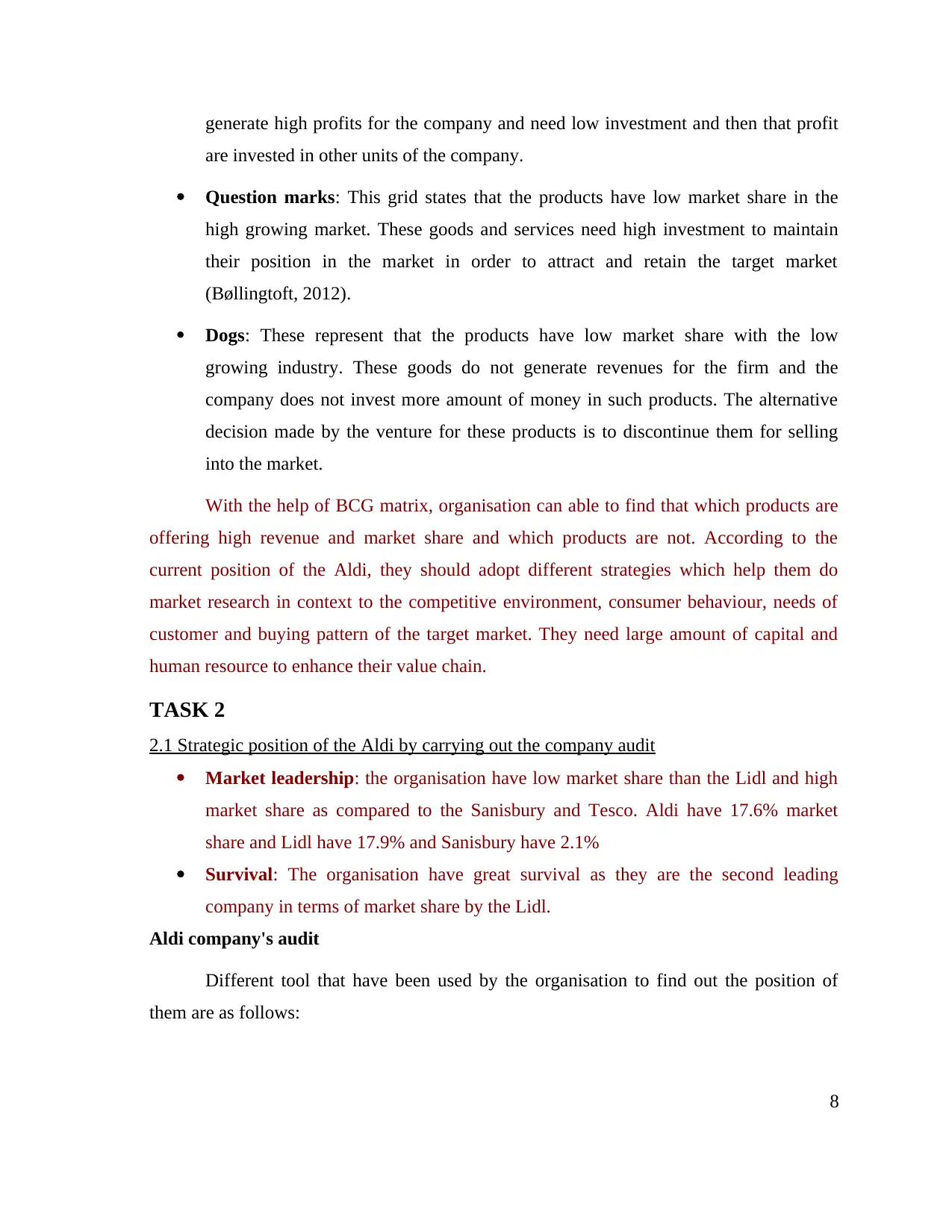
generate high profits for the company and need low investment and then that profit
are invested in other units of the company.
Question marks: This grid states that the products have low market share in the
high growing market. These goods and services need high investment to maintain
their position in the market in order to attract and retain the target market
(Bøllingtoft, 2012).
Dogs: These represent that the products have low market share with the low
growing industry. These goods do not generate revenues for the firm and the
company does not invest more amount of money in such products. The alternative
decision made by the venture for these products is to discontinue them for selling
into the market.
With the help of BCG matrix, organisation can able to find that which products are
offering high revenue and market share and which products are not. According to the
current position of the Aldi, they should adopt different strategies which help them do
market research in context to the competitive environment, consumer behaviour, needs of
customer and buying pattern of the target market. They need large amount of capital and
human resource to enhance their value chain.
TASK 2
2.1 Strategic position of the Aldi by carrying out the company audit
Market leadership: the organisation have low market share than the Lidl and high
market share as compared to the Sanisbury and Tesco. Aldi have 17.6% market
share and Lidl have 17.9% and Sanisbury have 2.1%
Survival: The organisation have great survival as they are the second leading
company in terms of market share by the Lidl.
Aldi company's audit
Different tool that have been used by the organisation to find out the position of
them are as follows:
8
are invested in other units of the company.
Question marks: This grid states that the products have low market share in the
high growing market. These goods and services need high investment to maintain
their position in the market in order to attract and retain the target market
(Bøllingtoft, 2012).
Dogs: These represent that the products have low market share with the low
growing industry. These goods do not generate revenues for the firm and the
company does not invest more amount of money in such products. The alternative
decision made by the venture for these products is to discontinue them for selling
into the market.
With the help of BCG matrix, organisation can able to find that which products are
offering high revenue and market share and which products are not. According to the
current position of the Aldi, they should adopt different strategies which help them do
market research in context to the competitive environment, consumer behaviour, needs of
customer and buying pattern of the target market. They need large amount of capital and
human resource to enhance their value chain.
TASK 2
2.1 Strategic position of the Aldi by carrying out the company audit
Market leadership: the organisation have low market share than the Lidl and high
market share as compared to the Sanisbury and Tesco. Aldi have 17.6% market
share and Lidl have 17.9% and Sanisbury have 2.1%
Survival: The organisation have great survival as they are the second leading
company in terms of market share by the Lidl.
Aldi company's audit
Different tool that have been used by the organisation to find out the position of
them are as follows:
8
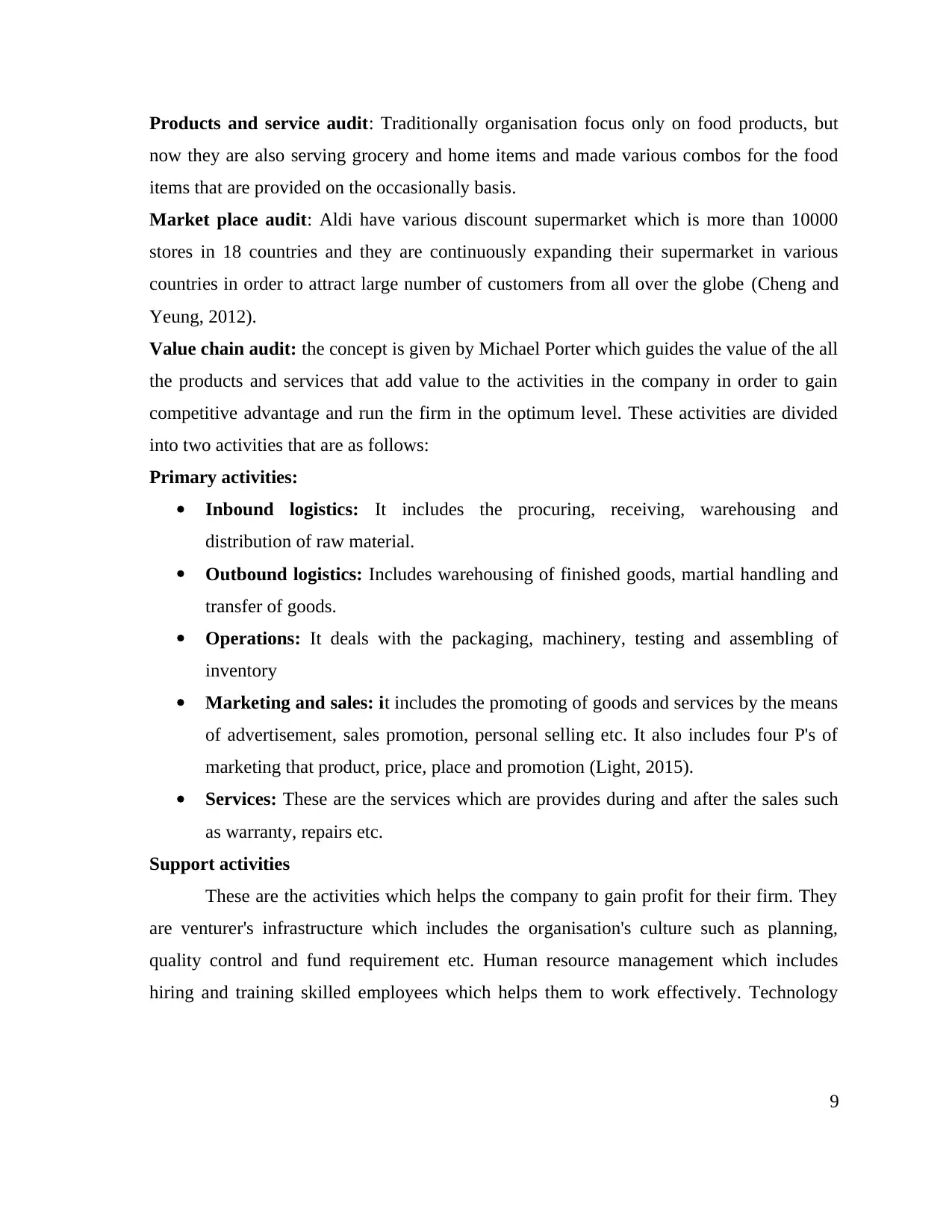
Products and service audit: Traditionally organisation focus only on food products, but
now they are also serving grocery and home items and made various combos for the food
items that are provided on the occasionally basis.
Market place audit: Aldi have various discount supermarket which is more than 10000
stores in 18 countries and they are continuously expanding their supermarket in various
countries in order to attract large number of customers from all over the globe (Cheng and
Yeung, 2012).
Value chain audit: the concept is given by Michael Porter which guides the value of the all
the products and services that add value to the activities in the company in order to gain
competitive advantage and run the firm in the optimum level. These activities are divided
into two activities that are as follows:
Primary activities:
Inbound logistics: It includes the procuring, receiving, warehousing and
distribution of raw material.
Outbound logistics: Includes warehousing of finished goods, martial handling and
transfer of goods.
Operations: It deals with the packaging, machinery, testing and assembling of
inventory
Marketing and sales: it includes the promoting of goods and services by the means
of advertisement, sales promotion, personal selling etc. It also includes four P's of
marketing that product, price, place and promotion (Light, 2015).
Services: These are the services which are provides during and after the sales such
as warranty, repairs etc.
Support activities
These are the activities which helps the company to gain profit for their firm. They
are venturer's infrastructure which includes the organisation's culture such as planning,
quality control and fund requirement etc. Human resource management which includes
hiring and training skilled employees which helps them to work effectively. Technology
9
now they are also serving grocery and home items and made various combos for the food
items that are provided on the occasionally basis.
Market place audit: Aldi have various discount supermarket which is more than 10000
stores in 18 countries and they are continuously expanding their supermarket in various
countries in order to attract large number of customers from all over the globe (Cheng and
Yeung, 2012).
Value chain audit: the concept is given by Michael Porter which guides the value of the all
the products and services that add value to the activities in the company in order to gain
competitive advantage and run the firm in the optimum level. These activities are divided
into two activities that are as follows:
Primary activities:
Inbound logistics: It includes the procuring, receiving, warehousing and
distribution of raw material.
Outbound logistics: Includes warehousing of finished goods, martial handling and
transfer of goods.
Operations: It deals with the packaging, machinery, testing and assembling of
inventory
Marketing and sales: it includes the promoting of goods and services by the means
of advertisement, sales promotion, personal selling etc. It also includes four P's of
marketing that product, price, place and promotion (Light, 2015).
Services: These are the services which are provides during and after the sales such
as warranty, repairs etc.
Support activities
These are the activities which helps the company to gain profit for their firm. They
are venturer's infrastructure which includes the organisation's culture such as planning,
quality control and fund requirement etc. Human resource management which includes
hiring and training skilled employees which helps them to work effectively. Technology
9
⊘ This is a preview!⊘
Do you want full access?
Subscribe today to unlock all pages.

Trusted by 1+ million students worldwide
1 out of 27
Related Documents
Your All-in-One AI-Powered Toolkit for Academic Success.
+13062052269
info@desklib.com
Available 24*7 on WhatsApp / Email
![[object Object]](/_next/static/media/star-bottom.7253800d.svg)
Unlock your academic potential
Copyright © 2020–2025 A2Z Services. All Rights Reserved. Developed and managed by ZUCOL.





